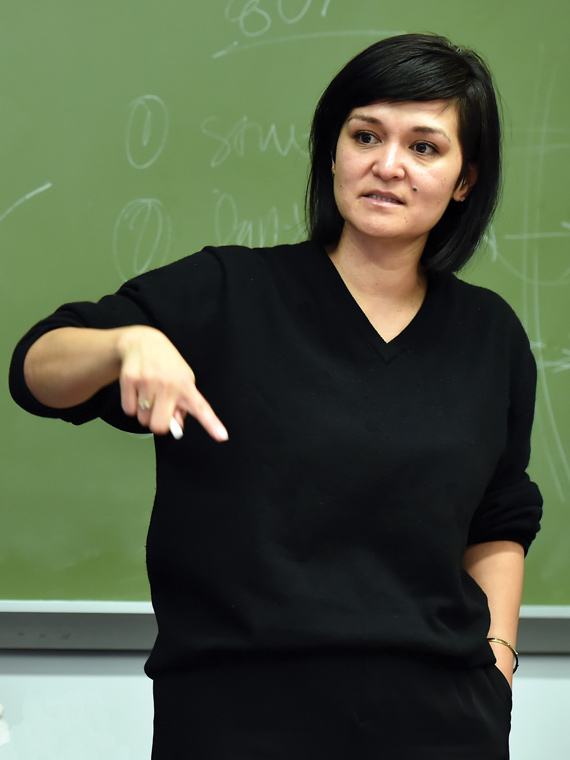Joanne Woodward Chair in Public Policy
on leave for 24-25
BA, University of Notre Dame. MA, PhD, Harvard University. Research interests include Latino and immigration politics, with special interests in migration control regimes, social movements, inequalities in citizenship, and religion in the United States and Spain. Current work compares the development of US and Spain enforcement regimes, their constructions of racialized “illegal” bodies, and their radical movements to dismantle the state’s migration control practices. Her first book project, Illegal Redemption, investigates the crucial yet contradictory role that the Catholic Church has played in challenging a growing and restrictive regime of immigration control in the United States in the contemporary period. Author of “From Prayer to Protest: The Immigrant Rights Movement and the Catholic Church,” a chapter in the edited volume, Rallying for Immigrant Rights, by Irene Bloemraad and Kim Voss. SLC, 2014–
Previous Courses
Public Policy
From Secure Communities to the DREAM Act: Critical Themes and Reflections in Immigration Policy, the Livelihoods of Migrants, and Societal Inequality
Open, Seminar—Spring
Immigration has been a recurring and polarizing political issue in the United States and globally. During the Trump administration, we witnessed sweeping changes to our immigration and enforcement systems. While some of those changes were sharp disjunctures from the previous Obama administration, others have roots and continuities with earlier administrations. Now, again, immigration is set to be a central part of public debate and policymaking. And yet, despite immigration having been a central part of public debate in contemporary politics, it is still debated as if it were ahistorical and decontextualized. In this semester-long course, students will explore critical themes in the study of immigration and policy. We will answer questions such as: How do federal, state, and local immigration policies and their linkages impact the livelihood of migrants, and what does that mean for the shaping of societal inequality? Where is the most effective location at which to effect policy change, why, and how? More specifically, this course will trace critical moments of immigration policymaking at multiple scales and in multiple arenas. We will also center the contemporary moment by exploring the policies of the Biden/Harris administration and situating these within broader trajectories of policymaking. Finally, students will contribute to ongoing debates by reflecting on where we are and what we can we do to create a better system and a more equitable society.
Faculty
Gold Hoops, Red Lipstick, and YHLQMDLG: The Cultural in Everyday Politics and The Political in Everyday Culture
Sophomore and Above, Seminar—Spring
While ideas of politics and policy change can focus on electoral and sometimes contentious politics, the role of culture is important in (re)shaping ideas and discourses on particular issues and as political acts in and of themselves. For example, the visual imagery, musical soundtracks, theatre productions of migrant justice, Black Lives Matter, climate justice, and many other social movements have aided in providing and disseminating counternarratives and political claims that disrupt everyday institutional politics. In doing so, these cultural productions can help to build movements and provide power to those on the outside seeking change. Everyday culture, however, can also be political. Alexandria Ocasio-Cortez and Sonia Sotomayor have raised the significance of gold hoops and red lipstick as fashion choices rooted in Latinx communities but also as symbols of disruption, as they are Latinx women traversing hegemonic political spaces. Trap artist Bad Bunny debuted his studio album, YHLQMDLG, during a mobile concert in New York that started in the Bronx, traveled through Washington Heights, and ended in Harlem. According to anthropologist Yarimar Bonilla, while on its face the concert was expressly apolitical, the route it traversed, the date it was planned, and the songs themselves posed a political critique of a history of governmental neglect; it marked the eve of the devastation of Hurricane Maria and traversed historically Latino communities that have been most devastated by the current pandemic. At the same time, the mobile concert provided Latino communities a respite, a moment of collective joy and celebration that was also a response and production of this time of social distancing and the end of large gatherings. Popular culture in the form of beauty, fashion, music, and other productions and practices is shaped by, and responds to, cultural, political, and historical forces in ways that can sustain or reject dominant hegemonic constructions. This course, then, aims to provide an understanding of how the political marshals culture, of how everyday practices of looking and consuming are mediated through fields of power, and of how these practices can become the locus of world-building for different marginalized communities. In centering culture in this course, race, immigration, and gender/sexuality become important axes of analysis, as they have been intimately linked with major social movements and with world-making on the margins. While the course will cover politics and popular culture historically, it will also highlight current movements and social issues and include a community engagement component that will help to situate the course’s themes in time and place.
Faculty
An Analysis of Activism
Read about Luisa Laura Heredia's “The Politics of ‘Illegality,’ Surveillance, and Protest” course in Sarah Lawrence Magazine.
